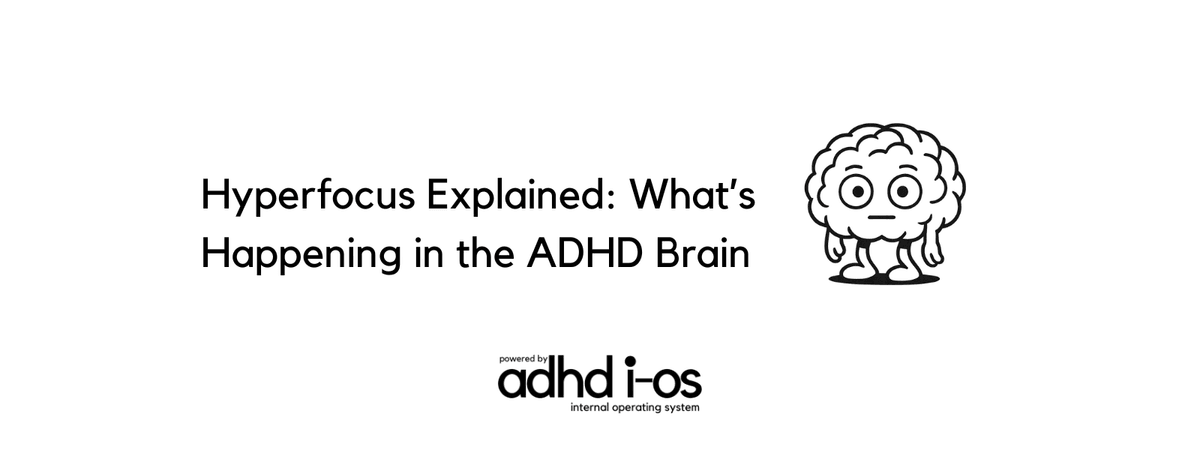Hyperfocus Explained: What’s Happening in the ADHD Brain
Hyperfocus Explained: What’s Happening in the ADHD Brain
Hyperfocus Explained: What’s Happening in the ADHD Brain
Ever lose hours deep in a project, forgetting to eat, drink, or even blink? And then you emerge feeling dazed, accomplished… and sometimes, totally drained?
Welcome to hyperfocus, a brain state that’s incredibly common among people with ADHD. It’s both a superpower and a struggle. On one hand, it can lead to creative breakthroughs and unstoppable productivity. On the other, it can feel like falling into a tunnel you can’t escape from even when you want to.
Let’s break down what hyperfocus really is, what’s happening in the brain, and how to harness it without letting it hijack your day.

What’s Going On Inside the ADHD Brain?
ADHD brains don’t produce or regulate dopamine the same way neurotypical brains do. Dopamine is your brain’s “interest fuel.” It sparks motivation, focus, and that sense of I want to do this.
Dopamine-Driven Reward Loops
In ADHD, dopamine levels are often too low or too short-lived. But when something finally does capture interest (aka, fun hyperfixation or thrilling deadline), dopamine surges, and the brain latches on hard. This creates a feedback loop: the more stimulating the task, the more dopamine, the harder it is to stop.
Hyperfocus in an ADHD brain is a byproduct of dopamine dysregulation. It creates tunnel vision when presented with highly stimulating input.
Executive Circuits Get “Stuck”
The prefrontal cortex (PFC), which is responsible for switching tasks, regulating attention, and making decisions, often functions differently in ADHD. That means once attention locks in, the brain has trouble shifting gears.
This is known as impaired cognitive shifting. Your brain physically struggles to stop focusing, even if the situation changes or other priorities come up.
So it isn’t that your brain can’t focus. It’s that you struggle to control what you focus on, and how long you are able to.
The Hunter vs. Farmer Theory
One evolutionary lens says ADHD traits (like hyperfocus) were once advantages. In fast-paced “hunter” environments, zeroing in on a moving target was critical to survival. The ability to hyperfocus was a feature, not a flaw.
But modern life often rewards farmers, or people who sustain consistent, low-stimulation tasks. This mismatch is why hyperfocus can feel both powerful and problematic today.
What the Research Says
Hyperfocus is widely reported by people with ADHD but hasn’t always been recognized in official diagnostic tools. Still, neuroscience is catching up.
- A 2021 study in Frontiers for Young Minds referred to hyperfocus as an “ADHD Superpower,” showing it can enhance creativity and productivity when channeled effectively.
- Brain imaging shows differences in structure and activity across the frontal cortex, basal ganglia, and cerebellum—areas tied to focus control and task shifting.
Yet, many professionals still don’t know how to identify or support it in ADHD treatment.
Strengths and Pitfalls of Hyperfocus
✅ When It Helps
- You can power through complex tasks or creative projects without distraction.
- You may achieve a deep “flow state,” leading to innovation or skill mastery.
- In short bursts, hyperfocus is a high-performance mode many neurotypicals envy.
⚠️ When It Hurts
- You might skip meals, ignore loved ones, or forget appointments.
- You may feel overwhelmed or guilty once you “snap out of it.”
- Tasks that don’t activate hyperfocus feel almost impossible to start.
Hyperfocus isn’t good or bad. It’s powerful. But without awareness, it can lead to burnout.
Brain Science, Simplified
Picture this:
- Your brain lights up like fireworks when it hits a high-interest task. Dopamine flows, focus narrows.
- But the PFC can’t hit the brakes. Your “task-switching system” is offline.
- Attention becomes a runaway train riding the rails of a dopamine spike.
That’s hyperfocus: a powerful ride with no emergency stop.
ADHD-Friendly Strategies to Work
With Hyperfocus
Cue Yourself Out
Use external alarms or calendar check-ins to break the trance. Timers are your tether.
Pre-Plan Breakaways
Build in mini-breaks and “task-shifting rituals” to help your PFC come back online.
Channel It Wisely
Save your most meaningful or creative work for when hyperfocus kicks in.
Set Boundaries Before You Start
Decide your end time before diving in and let a friend or body double know.
Balance Your Brain Chemistry
Exercise, micro-rewards, sunlight, novelty – these help regulate dopamine naturally and reduce the all-or-nothing pattern.
Tools & Support That Help
ADHD Coaches
Can help you recognize healthy vs. harmful hyperfocus patterns, and develop tools that work with your brain, not against it.
Apps
Try RescueTime, Pomodoro timers, or focus-mode apps to track time and create soft breaks.
Medication & Habits
When paired with supportive routines, ADHD medication can help smooth out the dopamine rollercoaster and make transitions easier.
Final Thought: Power with Intention
Hyperfocus is a neurodivergent strength. It’s not a glitch; it’s a unique way your brain responds to interest, reward, and motivation.
But strength without strategy can lead to exhaustion. So instead of fearing or fighting it, try understanding it.
Try This:
Reflect on your last hyperfocus moment.
- What triggered it?
- How did you feel afterward?
- What could help you come out of it next time?
The more you know about your brain, the better you can design systems that support it.
Want more tips on working with your unique internal operating system? Join the adhd i-os community today!

